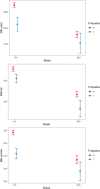Associations of production characteristics with the on-farm presence of Fasciola hepatica in dairy cows vary across production levels and indicate differences between breeds
- PMID: 37976265
- PMCID: PMC10656002
- DOI: 10.1371/journal.pone.0294601
Associations of production characteristics with the on-farm presence of Fasciola hepatica in dairy cows vary across production levels and indicate differences between breeds
Abstract
Fasciola hepatica is one of the economically most important endoparasites in cattle production. The aim of the present work was to evaluate the relevance of production level on the associations of on-farm presence of F. hepatica with farm-level milk yield, milk fat, and milk protein in Holstein cows, a specialised dairy breed, and in Simmental cows, a dual purpose breed. Furthermore, we investigated whether differential associations were present depending on breed. Data from 560 dairy farms across Germany housing 93,672 cows were analysed. The presence of F. hepatica antibodies was determined via ELISA on bulk tank milk samples. Quantile regression was applied to model the median difference in milk yield, milk fat, and milk protein depending on the interaction of breed and fluke occurrence. Whereas a reduction in milk yield (-1,206 kg, p < 0.001), milk fat (-22.9 kg, p = 0.001), and milk protein (-41.6 kg, p <0.001) was evident on F. hepatica positive German Holstein farms, only milk fat (-33.8 kg, p = 0.01) and milk protein (-22.6 kg, p = 0.03) were affected on F. hepatica positive German Simmental farms. Subsequently, production traits were modelled within each of the two breeds for low, medium, and high producing farms in the presence of F. hepatica antibodies and of confounders. On Holstein farms, the presence of F. hepatica seropositivity was associated with lower production, while on German Simmental farms such an association was less evident. This work demonstrates that production level is relevant when assessing the associations between the exposure to F. hepatica with production characteristics. Moreover, both models indicate a breed dependence. This could point towards a differential F. hepatica resilience of specialised dairy breeds in comparison with dual purpose breeds.
Copyright: © 2023 Oehm et al. This is an open access article distributed under the terms of the Creative Commons Attribution License, which permits unrestricted use, distribution, and reproduction in any medium, provided the original author and source are credited.
Conflict of interest statement
The authors have declared that no competing interests exist.
Figures

Similar articles
-
Breed-dependent associations of production characteristics with on-farm seropositivity for Ostertagia ostertagi in dairy cows.Parasit Vectors. 2025 Mar 5;18(1):91. doi: 10.1186/s13071-025-06728-9. Parasit Vectors. 2025. PMID: 40045409 Free PMC article.
-
Association between milk yield and milk anti-Fasciola hepatica antibody levels, and the utility of bulk tank milk samples for assessing within-herd prevalence on organic dairy farms.Vet Parasitol. 2021 Mar;291:109374. doi: 10.1016/j.vetpar.2021.109374. Epub 2021 Feb 9. Vet Parasitol. 2021. PMID: 33662712
-
Patent infections with Fasciola hepatica and paramphistomes (Calicophoron daubneyi) in dairy cows and association of fasciolosis with individual milk production and fertility parameters.Vet Parasitol. 2019 Mar;267:32-41. doi: 10.1016/j.vetpar.2019.01.012. Epub 2019 Feb 13. Vet Parasitol. 2019. PMID: 30878082
-
Random forest classification as a tool in epidemiological modelling: Identification of farm-specific characteristics relevant for the occurrence of Fasciola hepatica on German dairy farms.PLoS One. 2023 Dec 21;18(12):e0296093. doi: 10.1371/journal.pone.0296093. eCollection 2023. PLoS One. 2023. PMID: 38128054 Free PMC article.
-
Fasciola hepatica seroprevalence in Northern German dairy herds and associations with milk production parameters and milk ketone bodies.Vet Parasitol. 2020 Jan;277:109016. doi: 10.1016/j.vetpar.2019.109016. Epub 2019 Dec 27. Vet Parasitol. 2020. PMID: 31901738
Cited by
-
Fasciolosis in ruminants in Brazil.Braz J Vet Med. 2024 May 21;46:e002924. doi: 10.29374/2527-2179.bjvm002924. eCollection 2024. Braz J Vet Med. 2024. PMID: 38803825 Free PMC article. Review.
-
Animal health as a function of farmer personality and attitude: using the HEXACO model of personality structure to predict farm-level seropositivity for Fasciola hepatica and Ostertagia ostertagi in dairy cows.Front Vet Sci. 2024 Oct 2;11:1434612. doi: 10.3389/fvets.2024.1434612. eCollection 2024. Front Vet Sci. 2024. PMID: 39415948 Free PMC article.
-
Breed-dependent associations of production characteristics with on-farm seropositivity for Ostertagia ostertagi in dairy cows.Parasit Vectors. 2025 Mar 5;18(1):91. doi: 10.1186/s13071-025-06728-9. Parasit Vectors. 2025. PMID: 40045409 Free PMC article.
References
-
- Spithill TW. Fasciola gigantica: epidemiology, control, immunology and molecular biology. In: Dalton JP editor. Fasciolosis. 1st ed. CABI publishing; 1999. pp. 465–525.
MeSH terms
Substances
LinkOut - more resources
Full Text Sources

